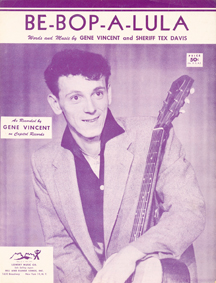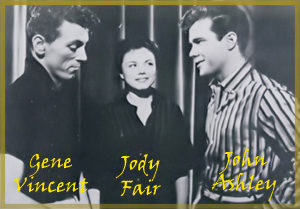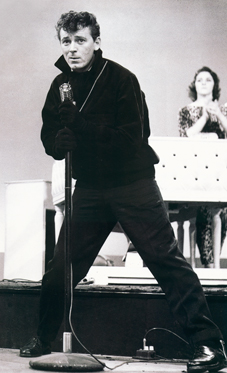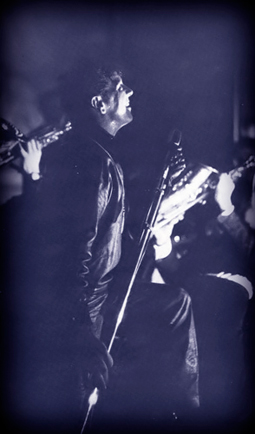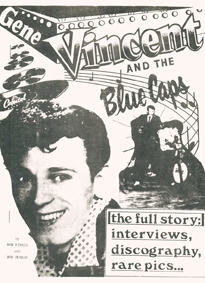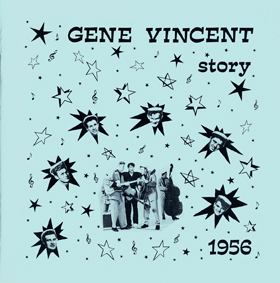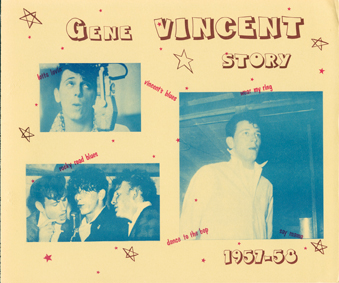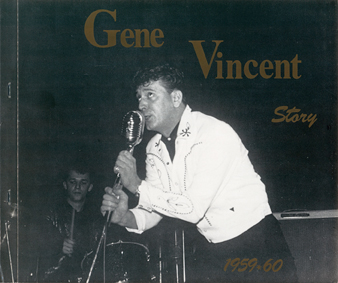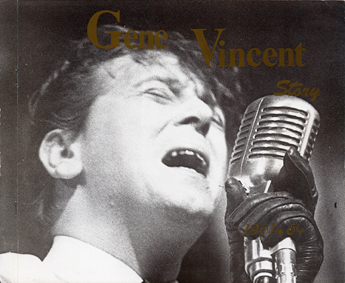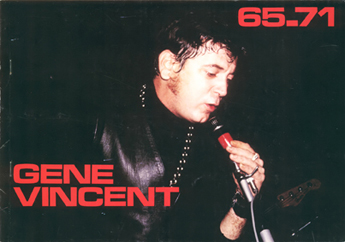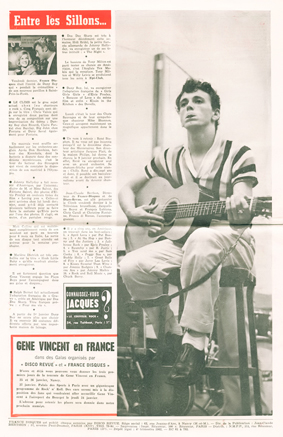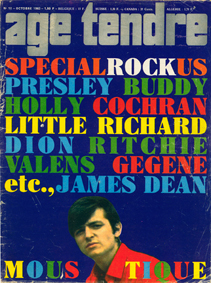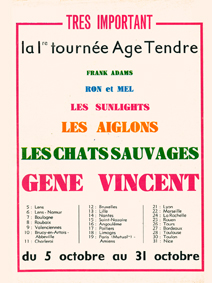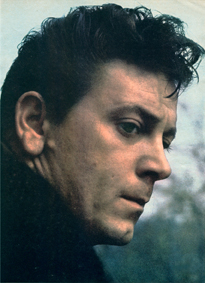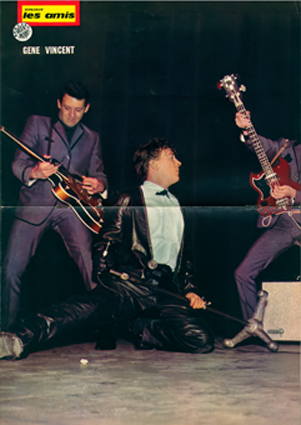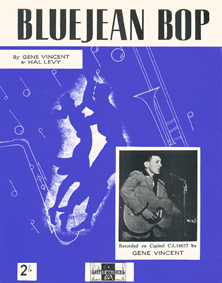
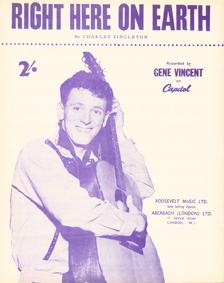
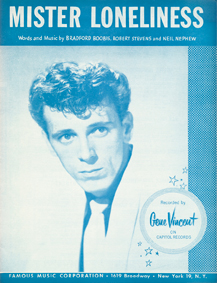
In 1956, he
was signed to Capitol Records by Ken Nelson and, at his first session in Nashville,
cut four classic tracks, including 'Be-Bop-A-Lula' and 'Race With The Devil'.
The Blue Caps proved to be so good that the usual session musicians who were generally called up to back those great early Rockers in the studio were allowed to get back home sooner. Quite rightly so, 'Be-Bop' was a smash hit - but also the only real big one
he ever had. Only 'Lotta Lovin' and, to a lesser extent, 'Dance To The Bop',
made some impact on the charts (both in 1957). However, he kept on recording
GREAT stuff until his untimely death on October 12, 1971. Some of these recordings
will be detailed and discussed in the various sections shown
at the top and bottom of this page.
The
photo at the top is one of my all-time favorites, and there are quite a few striking pics of Gene on stage ! It appeared on the French 'A Rockin' Date With Gene Vincent' album in 1963 (Capitol T 20532), a supremely tasteful collection of '56-'58 tracks which had never been released here at the time and which was the starting point of my addiction to rock'n'roll (I can't help thinking that it could still perfectly
function that way today for anyone interested in real music !). Mixing tracks
from Gene's first, second, fourth and fifth LPs - plus
'Well, I Knocked, Bim Bam' which originally only made it to a a compilation LP, 'Teenage Rock', Capitol T 1009 -, it's a killer from start to finish. Without any
sort of chauvinism, I must admit that the sound quality on this Pathé
Marconi pressing is far superior to the US or UK originals : just listen to
'Peace of Mind', 'I Flipped', 'I Got To Get To You Yet' or 'I Might Have Known'
and you'll agree with me, the spaciousness, fluidity and brightness of the
music are amazing. It has even become one of my main 'test records' for new audio kit.
Now, there's a couple of points I'd like to stress. First off, come to think
that, despite having only two real hot selling singles, Gene had the privilege
of having SIX albums released in the States (and the UK) from 1956 to 1960. Quite a feat in the Fifties, demonstrating once and for all that Capitol and the oft-criticized
Ken Nelson in particular had kept their faith in such a fabulous singer. Sure, as Colin Escott once explained, Gene also benefitted from Nelson's faith in the album format. That said, there are not tons of rock'n'roll LPs from that period that come close to Gene's, quality-wise.
Besides,
if we all agree that the very first edition of Gene & His
Blue Caps was VERY impressive, one shouldn't deny the fact that the following
combinations managed to maintain as high a level of musicianship. Like John Mayall in England during the sixties, Gene seemed to attract great musicians like a magnet : Cliff Gallup, Dickie Harrell, Paul Peek, Clifton Simmons, Grady Owen, Johnny Meeks, that's a pretty long list. The
music evolved and the later addition of session players like Jackie
Kelso was a definitive plus to songs like 'Say Mama' or 'Gone, Gone, Gone'.
By the time of his sixth album in 1960, titled 'Crazy Times' and his first one available in mono and stereo, the Blue Caps had disbanded and Gene recruited Jerry Merritt on lead guitar while the rest of the band consisted of veteran studio aces plus an up-and-coming legendary drummer, Sandy Nelson. Needless to say, it still rocked beautifully. Between
1960 and 1964, most of Gene's recordings were made in England often under the
supervision of Norrie Paramor. Various bands or orchestras were used
and it's true that some of the best tracks were cut with The Sounds Incorporated
; however, Gene's sessions from the Spring of 1964 with The Shouts deserve a
much better appreciation. The resulting album, 'Shakin' Up A Storm' (Columbia
33 SX 1646 in the UK and FPX 269 in France), was a superb latter-day Rock'n'Roll recital. Then, there were the revered Challenge sessions from 1966 and 1967 of course. It's only afterwards that things began to slowly weaken.
Gene had had his star on the Hollywood Walk Of Fame in the mid-60's and was inducted into The Rock'n'Roll Hall Of Fame in 1998. He remains one of the most charismatic performers and talented singers of all time. His
first manager and co-composer of 'Be-Bop-A-Lula', 'Sheriff' Tex Davis, used to say that he could sing
like a bird ; well, this bird has flown and the nest stays empty...
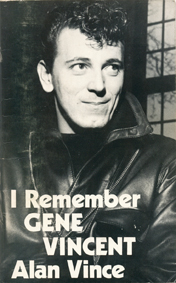
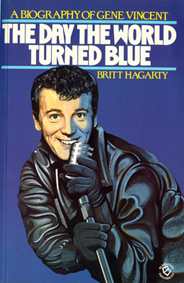
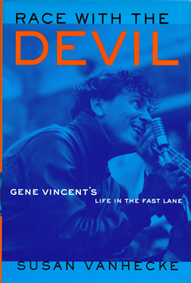
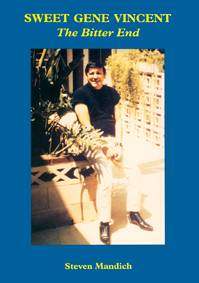
Gene's story has been well researched over the past decades, so rather than serve it again I thought it a better idea to examine and display some of the best publications on that - at the same time fascinating and distressing - topic.
In 1974, Rob Finnis & Bob Dunham published a valuable essay on Gene Vincent & His Blue Caps which was well written and well documented, and somewhat became the stepping stone for all that followed.
Alan Vince ran the Gene Vincent Fan Club in England froml 1960 to 1962 with Mike Bartlett. In 1977, he published his own personal account of Gene's life and career, 'I Remember Gene Vincent'. Although written from an early fan's point of view, it made for a very interesting read. In 1984, Canadian writer & musician, Britt Hagarty, pushed things a whole lot further and delivered a very detailed history of his career as well as a first, deep study of his strange persona. However good 'The Day The World Turned Blue' was, the definitive work on Vincent belongs to US journalist, Susan Vanhecke. Her meticulous research combined with her illuminating writing makes 2000's 'Race With The Devil' the book that best covers his 'life in the fast lane'. But 2002 brought us a worthy companion to Vanhecke's, 'Sweet Gene Vincent' by Steven Mandich. Based on multiple interviews, his book concentrates mostly on Gene's last years, with the bonus of a fly-on-the-wall account of his too often chaotic tours of England and France, but it also helps to better visualize the troubled mind that Gene Vincent really was.
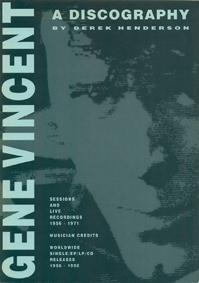
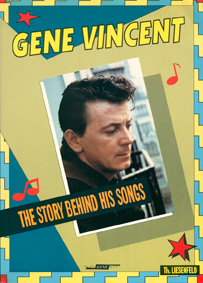
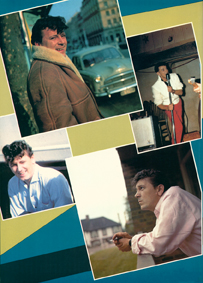
As far as discographies are concerned, Derek Henderson is one of the leading authorities here. Shown above his the first edition of his works. Also of interest is Thierry Lisenfeld's 'The Story Behind His Songs', which serves the purpose of listing all his songs with lyrics, composer credits, original performers and recording data.
It's now time to raise our hats to my good friends, Gérard Lautrey and Serge Schlawick, who published five stunning volumes of the Gene Vincent Story during the 80's, packed with fabulous photos and a wealth of information, which neatly complement all the above books. They're pictured on the opposite column.
Another enthusiast who must be thanked forever for his pioneering and painstaking dedication to Rock'n'Roll artists, is Alan Clark out of West Covina, California. The three main booklets he devoted to Gene are pictured below, crammed with rare & unseen pics, press clippings, disc reviews and all kinds of memorabilia.
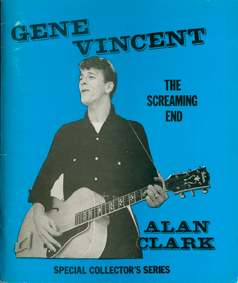
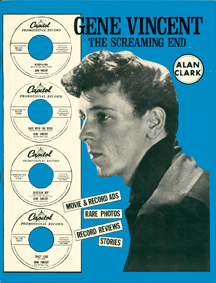
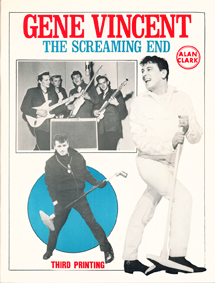
And of course, there's a multitude of magazines, old and more recent, to collect and treasure.
There was a flurry of articles on the 'Be-Bop-A-Lula Kid' in 1956 and into 1957, especially in mags dealing with C'n'W. Some of them appear below. Of course, the contents were of very small interest and showed how the Country Music community disdained Rock'n'Roll - and Gene in particular. One of the articles lifted from the September '56 issue of 'Country'n'Western Jamboree' is titled 'From Out Of Nowhere', without even citing the artist's name ! Interestingly, the 'Vincent Visits Nashville' bit, taken from
the April '57 issue of 'Country Song Roundup', clearly shows that Gene didn't feel comfortable with all those DJs at the 1956 Nashville Convention, a favor the DJs were quick to return by 'cutting him down' as Johnny Carroll sang in his wonderful tribute, 'Black Leather Rebel'. By 1958, Gene was quasi-absent from most US mags.
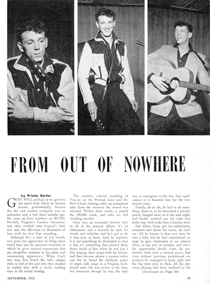
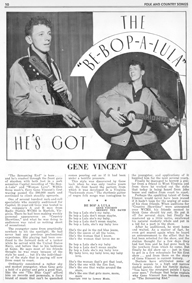
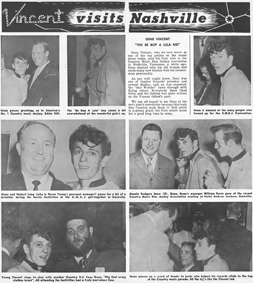
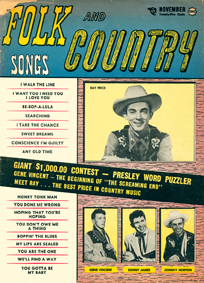
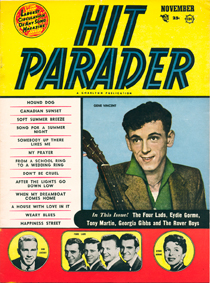
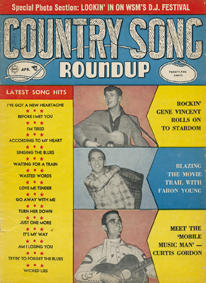
The next phase of his career would take place in Europe, England and France in particular. Gene became a myth, thanks both to his brilliant recorded work and his second-to-none stage shows.
In France, although some of Gene's Capitol stuff had been released prior to 1960, the bulk of his catalog was made available after that date, which more or less coincided
with his numerous stays in our country.
Please enjoy a sample of some of France's best known Rock'n'Roll mags and their great Gene Vincent covers.
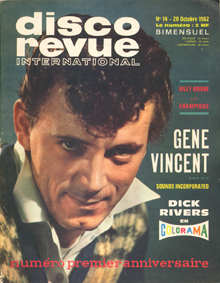
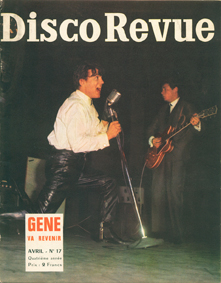
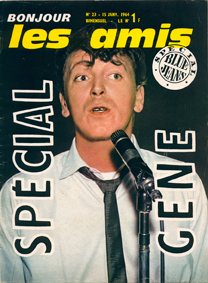
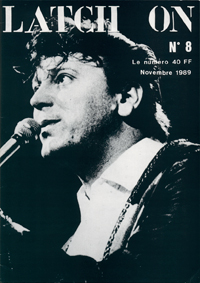
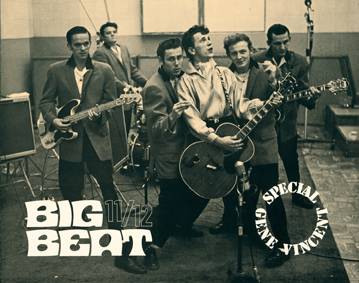
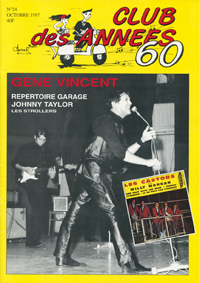
Disco Revue, founded by Jean-Claude Berthon in 1961, remains by far the best ever mag we ever had ; Berthon really knew what Rock'n'Roll was all about and his fabulous covers were the perfect graphic counterparts of the music we love the most. 'Bonjour Les Amis' was really 'Salut Les Copains' number two but their January '64 special Gene Vincent issue is nothing short of phenomenal, with many photos exclusive to that very mag. There's also a graphological study of Gene which, whatever the (perhaps dubious) reasons behind it, proved extremely right ('a character full of complexes who always lies about his own personality'). We also learn there that Gene used to wear a right hand glove on his left hand 'because of a stiffness due to a fractured thumb' following the 1960 car crash. But the fun is spoiled when they give 'May 18, 1936' as Gene's birth date and when they write that Eddie Cochran died in...1958.
Later mags obviously benefitted from deeper research on the artists, more polished writing and better printing but in the end, these rags are all essential for our collections and our appreciation of the music.
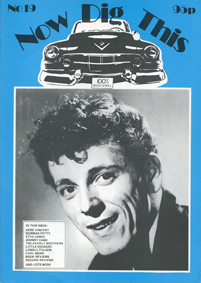
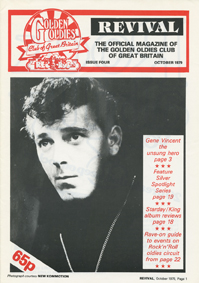
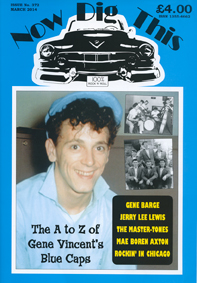
Here are now a few British Rock'n'Roll mags to end up in fine fashion. 'Now Dig This' is the best they ever had, at least as far as 50's rock and roll is concerned. They've been rockin' for 35 years, delivering one monthly gem after another. As you can imagine from the mere view of issues #14 from 1984 (at left) and # 372 from 2014 (at right), Gene's story was masterly covered from A to Z with rare photos galore to boot.
In the middle, there's issue #4 (October 1979) of the short-lived 'Revival' Magazine which was published by The Golden Oldies Club Of Great Britain. That club's objectives was two-fold : to unify all British rock'n'roll clubs and associations (they failed), and to help re-release classic 50's and 60's recordings via a series of singles on their own label (here, they succeeded and their limited-edition Everly Brothers singles set from 1980 was superb).
Gene Vincent was a real outcast, an outlaw in a compromised and merciless music business he didn't care about. He was happy as long as he could sing for his fans. Thus, he became an easy prey for unscrupulous managers and tour promoters, and they were plentiful. Meanwhile, his private life was a mess but I guess it probably had to be that way. He nevertheless gave us some of the greatest rock and roll ever commited to wax and a stage act that still haunts all those who were lucky enough to attend it. In some ways, if Elvis had the talent and the looks, Gene had the talent and the integrity. To many of us, he's always been The Boss.
© PAUL VIDAL * Privas, France * 1998 - 2024


